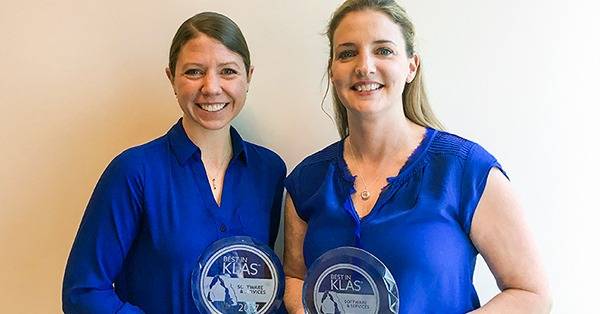- Solutions
- Solutions
- Home Health
- Hospice
- Life Plan Community
- Palliative Care
- Private Duty
- Senior Living
- Skilled Nursing
- Skilled Nursing
- Skilled Nursing Software
- Advanced Insights
- Customer relationship management
- Data and analytics
- Financial & operations management
- Marketing
- Nutrition management
- Referral management
- Regulatory compliance
- Retail management
- Resident engagement
- Revenue cycle management
- Skilled nursing interoperability
- Partners
- Blogs
- Resources
- About
- User Conference

How technology is shaping the value-based care revolution
Long-term care providers have experienced a massive shift under value-based care, which offers incentives for providers to focus on quality outcomes rather than the quantity of services rendered. Despite the major shifts involved in this model, generally providers see the change as a positive development. The focus on getting and keeping people healthy, lowering rates of rehospitalization and improving objective quality measures has led to better clinical results and quality of life for millions of residents.
With ongoing challenges including staff shortages, more complex care needs, and financial uncertainty from payors, technology can play a key role helping long-term care providers make the shift to value-based care and reap its benefits. We’ll explore how some new tools can help you better manage challenges, from improving outcomes to regulatory compliance and quality measurement.
The right data at the right time
Most EHR systems today can deliver a lot of data. But these solutions should do more than just gather information. Technology providers need to develop tools that make sure the right data is gathered and delivered to users and is actionable. Reports need to be relevant for users and their partners who also operate in the value-based business environment, so they have the data they need to demonstrate their facility’s effectiveness. And of course, using the data should be seamless and intuitive. Technology should support decision making that helps lead to better health outcomes, and near real time reports should be available to demonstrate the quality and value a setting can provide to the network.
Most providers are seeing increased clinical and social complexity in the residents for whom they provide care. There are family members and multiple care teams, as well as more care modalities. Caregivers need data that accurately reflects the resident’s condition and helps them deliver the right care at the right time. It’s not only about making sure your organization is properly reimbursed. You also need information that accurately reflects all the complexities of each resident for reimbursement purposes, of course, but you also need accurate and comprehensive resident information to develop a patient-centric care plan, to support high quality decision-making and to accurately reflect the care your setting delivers through quality metrics and others.
Interoperability is foundational
The responsible sharing of data between all stakeholders is the foundation for high quality care. That’s because resident care is influenced and directed by many key people: the primary care physician, care specialists, the hospital, the senior living facility and its care providers, therapists, family members, and the residents themselves.
Each of these stakeholders has valuable information that is, too often, contained within silos. To support the best possible care coordination and resident-centric care, all of these stakeholders need the ability to share data in a timely, responsible manner. Imagine the power of having a longitudinal record of a resident’s journey, including a summary of prescriptions, and then using artificial intelligence to analyze and predict interactions and other outcomes. With this information, all the different stakeholders could optimize outcomes and help minimize costs by looking at comprehensive, holistic data. This scenario shows how value-based care and new technologies like AI can work hand in hand.
Leveraging technology for better care
Health journeys are complicated. With so much data available, filtering through it to determine what’s meaningful is increasingly difficult. In the “old days,” caregivers had to sift through hundreds of pages of a resident’s record—and that was before we understood the importance of so many other factors, including social determinants of health.
But now, AI tools allow providers to quickly gather relevant data that can support decisions, and also see subclinical changes that may be meaningful, such as heart rates that are trending in a negative direction but not yet flagged by “out of range” parameters. These advanced technologies allow us to know an individual resident’s target range, see if there are changes, identify other factors that could contribute to that change, and alert caregivers to take a look and determine what action to take. We know that early identification and intervention supports a better patient experience and higher probability of a high-quality outcome.
I’ve heard some anxiety about technology “taking over” the role of the clinician, but simply stated, that can’t and won’t happen. AI and ML tools are good for gathering data and illuminating patterns, but a clinician has to analyze the insights and determine the right actions. Technology helps get clinicians data more quickly, and can take over some of the mundane tasks clinicians currently do, freeing them up to work at their highest level and focus on determining the right plan of care for residents. These tools are not a substitute for clinical understanding, experience and decision-making.
Technology’s impact on costs
How can new technology tools help providers generate savings while also improving outcomes under value-based care models? Resident falls are a great example. We know falls can cost a facility as much as $65,000 per episode* on an annual basis, and that people over the age of 65 are very likely to fall at least once in a care facility or in their home. AI tools can monitor thousands of data points and surface those patients that are at most risk for falls based on data put into the medical record in combination with existing data.
Those data points help caregivers create comprehensive, person-centric care plans and take proactive steps to keep residents safe. Technology helps you provide personalized, proactive care that allows the resident to maintain their highest level of function, remain at the appropriate level of care, and have the highest quality of life. By providing person-centric care and preventing negative outcomes, we can avoid the cost associated with events such as falls and unnecessary hospitalizations.
Looking ahead, when more stakeholders and more data are layered into EHR systems, we will be able to more effectively identify those at risk for depression or see early indicators for potential respiratory decline, infection or other conditions, and deliver care that can improve outcomes and deliver results that support success in value-based relationships.
Help for ongoing staffing challenges
Everyone in the industry is aware of the population’s demographic shift. There will be many more seniors needing care and fewer healthcare workers entering the market. In addition to the efficiencies already covered in terms of eliminating mundane data gathering and entry tasks, AI tools are in development that will allow EHRs to automatically scrub and propose appropriate, comprehensive responses aligning with the complexity of the care being delivered for clinical experts to review and submit. This has the potential to save significant time and help MDS coordinators work at their highest level of function and efficiency.
The next frontier that will transform how healthcare operates will be “smart” SNF rooms: for example, sensors that can monitor activity, or wearable devices that can transmit key resident data, where information is shared across the network so caregivers and family are informed and can take action as needed. All of these tools will ease the burden on caregivers and help them focus on the things only they are able to do and perform at their highest level to support their residents and organizations.
The future of value-based care
There’s really no escaping it: value-based care is here to stay. When done right, it’s better for the residents, and it can be better for healthcare providers, too. Having the right tools in place to leverage what’s already here and what’s on the horizon can position your organization for continued success.
Request a demo today for a closer look at MatrixCare.
Allison Rainey
As our Head of Nursing and Clinical Informatics, Allison Rainey oversees the deployment of clinical technologies. As a Registered Nurse and License Family Practitioner, Allison drives a caregiver-first approach in our products, collaborating closely with product leaders to ensures our products and services prioritize the needs and challenges faced by healthcare providers. By aligning workflows, designs, and overall product strategy, Allison strives to offer the most user-friendly, clinically superior, and efficient suite of comprehensive solutions in the industry. Allison brings extensive post-acute care experience from her 20-year tenure at NHC, one the largest publicly traded Senior Care providers in the U.S. She is a seasoned leader in population health management strategy, clinical reporting and analytics development, and inpatient hospital care. In her most recent role as AVP of Clinical Information Technology, she oversaw the deployment and utilization of various clinical technologies, including the MatrixCare EHR, across the extensive NHC network. Allison holds a Bachelor’s and a Master’s in Nursing from the University of Tennessee.
Related Posts

See MatrixCare in action
Start by having a call with one of our experts to see our platform in action.
MatrixCare offers industry-leading software solutions. Thousands of facility-based and home-based care organizations trust us to help them improve efficiency and provide exceptional care.
© 2026 MatrixCare is a registered trademark of MatrixCare. All rights reserved.







